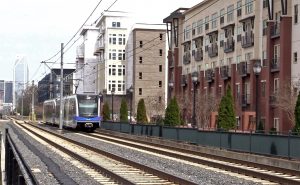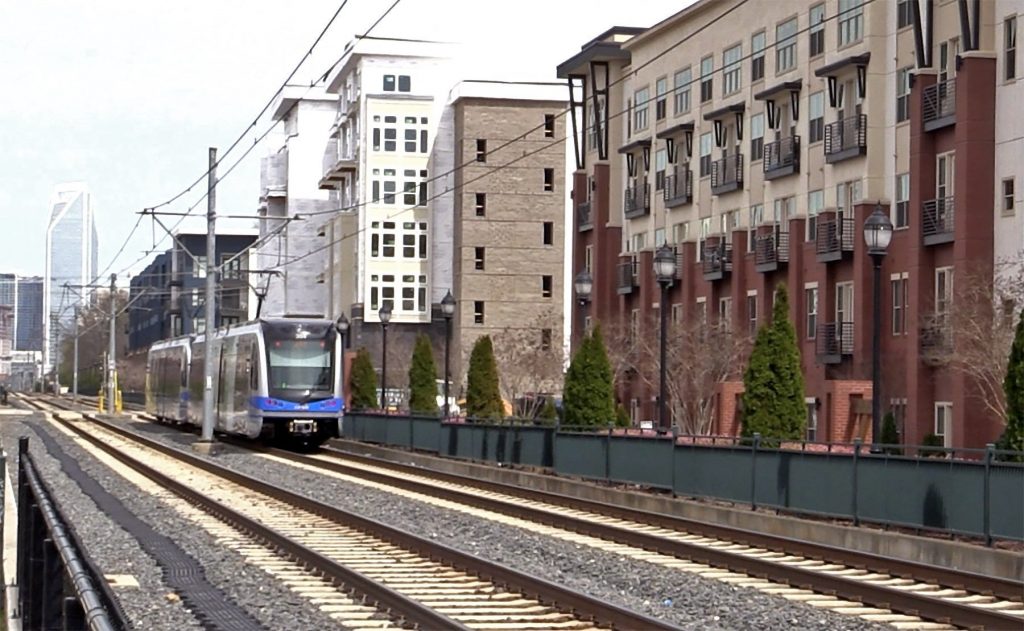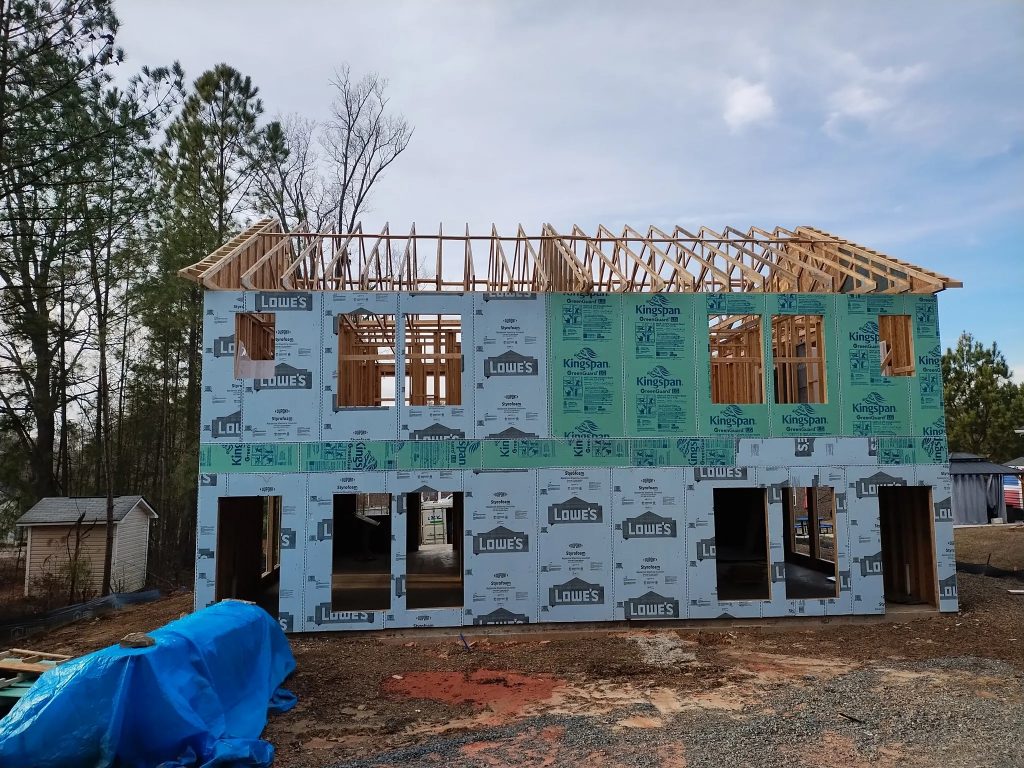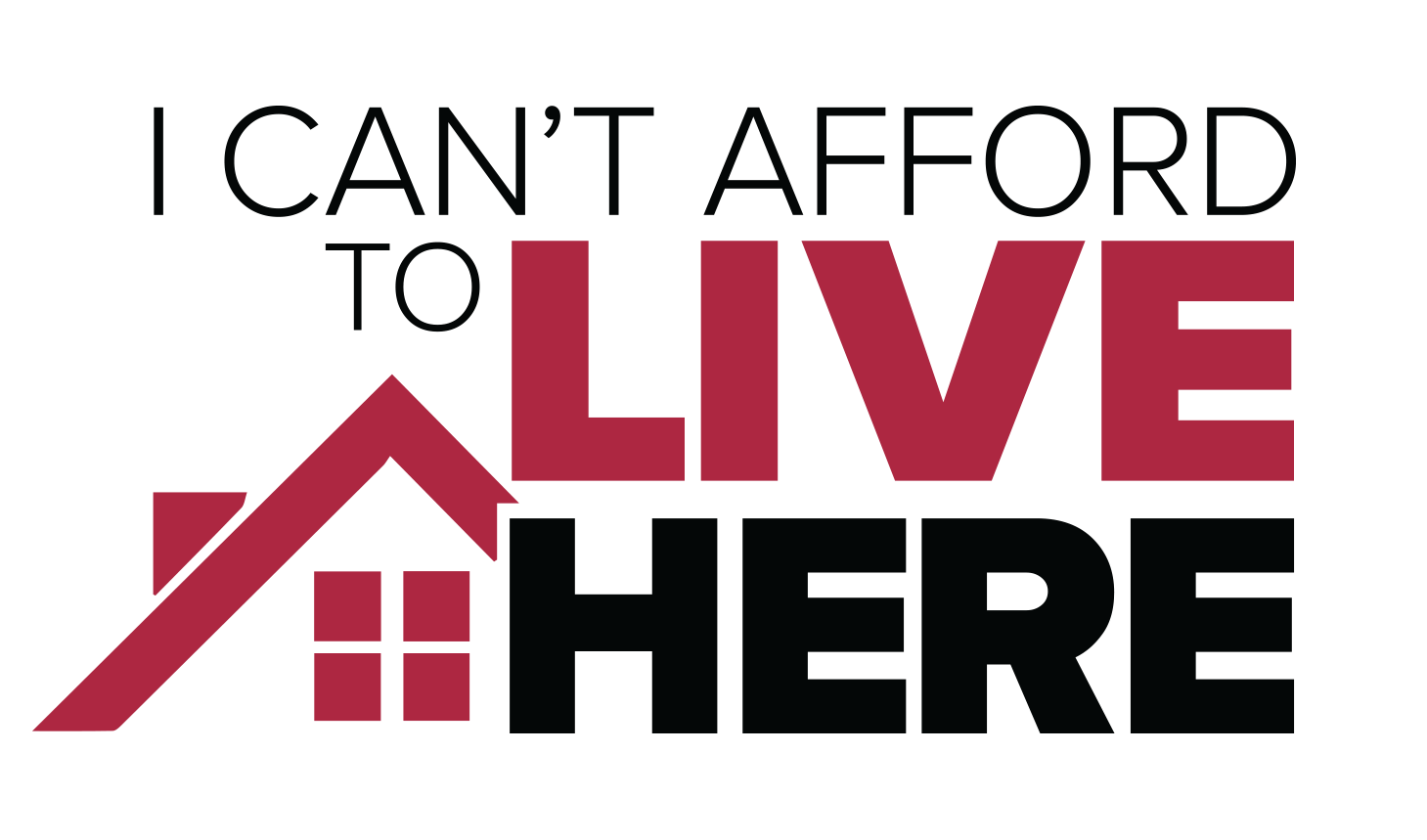
A light rail train passes through New Bern Street at Rail Crossing Lane station heading to uptown Charlotte.
Charlotte’s history of affordable housing includes broken promises and empty gestures. Now that the city’s chronic shortage has become a crisis, leaders are responding with unprecedented resources. Will this time be different?
By Pam Kelley
Anyone who’s lived in Charlotte for a minute knows that the Ballantyne area, wealthier than Mecklenburg County as a whole, isn’t the place to find an affordable apartment if you’re a hotel housekeeper, a fry cook, a landscaper – anyone making less than $15 or so an hour.
But back in 1991, when the affluent mega-neighborhood was still a gleam in a developer’s eye, Mecklenburg County commissioners approved a document that suggested a new era of mixed-income housing in south Charlotte.
The “Standards for the Development of Ballantyne” document, approved with the project’s rezoning, stated the developer’s intention to build a variety of housing for rent or sale, “priced to accommodate all levels of income represented by Ballantyne’s workforce.”
Some lower-priced houses were built, but nothing for low-wage workers. And Ballantyne, with million-dollar homes but no subsidized housing developments, became another chapter in Charlotte’s history of affordable housing that never happened.
This history stretches back to 1960s urban renewal, when Charlotte conducted an epic tear-down of low-cost housing occupied by black people, then failed to replace much of it. “Adequate housing for low income residents is perhaps the most pressing single need in Charlotte,” a Charlotte Observer editorial declared in 1968.
The story continues today, as the Lynx Blue Line zips past thousands of new luxury apartments but few affordable ones, even though a city policy encouraged affordable housing along the route.
Charlotte’s shortage is now described as a crisis, with an estimated deficit of 34,000 below-market units. Most are needed for people making 60 percent or less of the area’s median income, which is $79,000 for a family of four. This deficit likely underestimates actual needs, housing professionals say, because older, cheaper apartments are being demolished or upgraded faster than they can be replaced. Charlotte has added an average of 312 city-subsidized units a year over the past decade, according to a recent report.
The city’s popularity exacerbates this shortage, as growth outpaces construction, driving up prices. Local rents have climbed 45 percent since 2010 and now average more than $1,100 a month. In many ways, these problems, fueled by stagnant wages and gentrification, mirror housing shortages in urban areas around the world.

In one way, though, Charlotte stands out. In 2014, a groundbreaking study of U.S. social mobility ranked Charlotte last, 50th among 50 of America’s largest cities. The study revealed that children here who were born poor mostly stay poor, that Charlotte wasn’t the opportunity-rich place many citizens assumed. It was, in fact, the opposite – a city rife with economic inequality. A local task force tagged a lack of affordable housing as a major cause.
Today, spurred by that last-place social mobility ranking, Charlotte has launched the most intense push for affordable housing in its history.
In November, voters approved a $50 million Housing Trust Fund bond, more than triple the $15 million bonds of the past. A Foundation for the Carolinas campaign has nearly matched that $50 million with private gifts. Banks and other institutions have pledged nearly $100 million in land, down-payment assistance and below-market housing loans to developers. County commissioners, who usually leave most housing issues to city government, just allocated $11 million for rent subsidies.
This cash infusion offers Charlotte the chance to expand existing programs and try new solutions – paying developers to preserve older, affordable apartments, buying land for future housing, developing a metrics system to track progress. But it also begs the question: What took so long?
Blame the shortage partly on circumstances beyond Charlotte’s control. U.S. cities once relied on federal money to subsidize their low-cost housing, but in the 1980s, the Reagan Administration and Congress gutted the housing budget, which never recovered. The federally funded Charlotte Housing Authority now serves about 16,000 residents with its apartments and housing vouchers, only 500 more than in 1999, when the city had 300,000 fewer people.
Also, North Carolina doesn’t give local governments the authority to take actions other cities and states use to promote economic equity – requiring developers to include affordable units and prohibiting landlords from automatically rejecting tenants who pay rent with housing vouchers, for example. Housing activists argue that state legislators’ unwillingness to allow such policies obstructs real reform.
But Charlotte is at fault, too, they say. The city, with its world-class ambitions, has long measured its progress in skyscrapers and professional sports teams, not poverty reduction. Over the years, it has convened housing task forces, hired consultants, received reports, then repeatedly failed to follow their recommendations.
Also, until recently, few city leaders acknowledged institutional racism’s role in shaping housing patterns and creating a racial wealth gap that holds even among the poor. Nationally, an average white household living near the poverty line typically has $18,000 in wealth, while a similar black household has a median wealth near zero, according to a 2018 report by Duke University’s William Darity Jr. and others.
“Without acknowledging the racial component, people foster the stereotype that assistance with housing is a handout to the unworthy,” says Peter Kelly, a founder of Equitable Communities CLT, which advocates for affordable housing. The stereotype makes it easier to ignore the problem. It also helps drive fierce neighborhood opposition to subsidized apartments.
Today, as Charlotte attempts a course correction, housing advocates and elected officials lament recent decisions – a failure to reserve land for affordable housing along light rail, sales of surplus property that could have been used for housing, deals with developers that should have included affordable housing units.
“There’s this mentality, we should be nice to the developers,” says Charlotte Mayor Pro Tem Julie Eiselt. “There’s an unwillingness to push for more.”
These recent missed opportunities are only the latest.
The tear-down era
It was a February evening in 1960 when Vernon Sawyer, director of Charlotte’s Urban Redevelopment Commission, stood before some 150 residents of the city’s Brooklyn neighborhood and attempted to reassure them. “When the time comes to move,” he promised, “you’ll be given help in finding good homes you can afford.”
Afterward, Sawyer confided to a Charlotte News reporter covering the meeting that he’d been nervous. No wonder. He was overseeing Charlotte’s urban renewal, the biggest facelift in city history. Brooklyn, the heart of the black community, was the first area slated for demolition.
In Charlotte, inadequate housing has never been a race-blind issue. During slavery, area plantations housed enslaved black people in primitive quarters. After emancipation, these people had to find shelter.
It’s hard to find sources documenting the plight of newly freed people around Charlotte, says Willie Griffin, the Levine Museum of the New South’s historian. But a 1964 history, Frenise Logan’s “The Negro in North Carolina, 1876-1894,” describes conditions families likely endured – one-room, dirt-floor houses furnished with no more than a straw mattress and table, well water contaminated by sewage, a lack of decent clothing, food and firewood. Logan quotes a New England woman writing about these conditions in Wilmington in 1880: “I have visited scores and hundreds of houses huddled in festering heaps under every hill and on every alley; it is impossible to look…in any direction and not be nauseated by them.”
What we know about Charlotte specifically is that by 1890, former slaves and their descendants had settled in several areas, including Brooklyn, also known as Second Ward, the southern quadrant of uptown Charlotte.
By the 1950s, Brooklyn had become the heart of the black community, a city within a city, populated with homes, businesses, schools and churches. Some homes were good quality, owned by teachers and business owners, but much of Brooklyn’s housing was substandard white-owned rentals, shanties lacking indoor plumbing and furnaces.
By 1960, the city had decided Brooklyn had to go.
The initial aim of urban renewal was to replace substandard dwellings with decent housing. But in many cities, including Charlotte, the federal program evolved into a vehicle to remove black people from valuable land adjacent to downtown. Providing housing for displaced families became, at best, a secondary goal.
Brooklyn’s destruction displaced more than 1,000 families and launched a season of tear downs. Highway construction also took homes, and the city used its new 1962 housing code to condemn unfit, unsafe structures. Between 1963 and 1975, the city tore down more than 11,000 homes, according to a 1978 Observer story. Most were in black neighborhoods.
Charlotte leaders balked at building new low-cost housing. In a 1960 article, Sawyer deemed new construction unnecessary; “leading real estate agents” had assured him the city’s existing supply was adequate.
But by the early 1960s, Charlotte had fewer public housing apartments – 1,420 units – than smaller cities, including Charleston, S.C., according to a 1962 Observer story. Its headline: “City Far Behind in Public Housing.”
The federal government delayed Brooklyn’s demolition until the city promised to build 600 public units – Earle Village and Edwin Towers. Those weren’t enough. The Observer reported on relocated families unable to pay their new, higher rent and utilities. In 1968, an editorial about the city’s housing shortage scolded: “The City Council and its bashful handmaiden, the Housing Authority, acted for many years as if public housing were socialistic and dangerous.”
Demolitions continued into the 1970s, as urban renewal expanded to the black neighborhoods of First Ward and Greenville. This time, however, residents sued the city in federal court and won a promise of decent replacement housing that included rent subsidies.
Ted Fillette, now retired, was a young lawyer with the Legal Aid Society of Mecklenburg County assigned to monitor the city’s compliance. “People weren’t getting their rights,” he says. “Either they were paying more than they could afford or being placed in housing that was substandard.” He took city officials to court four times to enforce compliance. He prevailed each time.
Also volunteering for Legal Aid was Tom Ross, then a Davidson College student. Ross, former president of Davidson College and the University of North Carolina system, heads the Volcker Alliance, a nonprofit working for effective management of government.
For years, Ross has explained his decision to pursue a law career with a story about his work with Legal Aid. He’d been assigned to visit addresses on a city-provided list of houses for displaced residents to make sure they were in decent shape. “The law required that before they tore down somebody’s house, they had to relocate them into housing that met the housing code,” he says.
He discovered what he describes as “a mountain of housing code violations.” And that wasn’t all. Some addresses on his list simply didn’t exist.
Ross says this was no mistake. It happened repeatedly. “It looked like a clear pattern.”
Litigation over Charlotte’s urban renewal continued into the late 1970s. Ultimately, the city agreed to build seven small apartment complexes for people displaced by urban renewal or housing code enforcement.
But Vernon Sawyer didn’t keep that promise he made to Brooklyn residents in 1960. And in a 1980 interview with the Observer, he admitted as much. The program’s major error, he said, was its failure to plan to house displaced people. Still, he said, “I’m convinced it turned out better than I had any right to expect when we started.”
Affordable intentions in Ballantyne
By the 1990s, urban renewal was history. Charlotte newcomers wouldn’t have guessed that the uptown area that included Marshall Park, First Baptist Church and various government buildings had been a thriving black neighborhood known as Brooklyn. Mecklenburg County was growing, especially in the southern suburbs, where developers unveiled plans in 1991 for a 1,764-acre development that the Observer described as “one of the most ambitious ever envisioned for Charlotte-Mecklenburg.”
The developers, brothers Johnny and Cameron Harris and their sister, Sara Harris Bissell, now deceased, were the grandchildren of the late Cameron Morrison. Morrison is best known as North Carolina’s governor from 1921 to 1925, but remembered locally as the owner of Morrocroft, a dairy farm estate that sprawled over several thousand acres in what’s now south Charlotte.
When those acres passed to grandchildren, real estate became the family business. By the time the family announced Ballantyne, they’d already developed a good chunk of south Charlotte – subdivisions, office buildings, retail around SouthPark Mall – with acreage carved from the estate. Ballantyne took the last of the undeveloped land.
Today, Ballantyne is the upscale address of 25,000 residents, a corporate office park, a country club and golf course, and The Ballantyne, the luxury hotel where President Obama stayed during the 2012 Democratic National Convention in Charlotte.
But like most of south Charlotte, it’s an affordable housing desert.
This was what housing advocates had feared. At a 1991 rezoning hearing, Louise Woods who later became a school board member, submitted a letter signed by eight activists requesting that the Ballantyne proposal include “a section of affordable moderate- and low-income housing,” according to an Observer story.
Woods and other school advocates saw mixed-income housing as the city’s best shot at naturally integrating neighborhoods and schools. Charlotte-Mecklenburg schools were still under federal order to desegregate, still using busing to integrate.
Booming growth meant new suburban schools in mostly white areas. These created longer bus rides that strained the system’s complicated logistics. Busing and magnet schools didn’t seem enough to preserve integration. (In 1999, a federal judge would cancel the desegregation order.)
Responding to calls for affordable housing, Harris assured commissioners he planned to build for various income levels, with some homes starting around $90,000 to $110,000, about $169,000 to $207,000 in today’s dollars. At the public hearing, one woman reacted: “That’s not in any way low- to moderate-income.”
A month later, county commissioners approved the rezoning, along with standards stating the developer’s intention to build rental and for-sale housing “priced to accommodate all levels of income represented by Ballantyne’s workforce.”
The document gives no other details. It doesn’t mention low-cost or below-market housing, and the statement was only an intention, not a requirement. Harris says he recalls a signed agreement committing his family to including affordable homes, and he says they made good on that promise with about 160 homes priced below other Ballantyne houses.
The least expensive, 75 starter homes, were built in a neighborhood called Ballantyne Meadows, off Ballantyne Commons Parkway near U.S. 521, he says. The small-lot houses range from about 1,300 to more than 1,800 square feet and originally sold in 1998-99 between $111,000 and $176,500, according to real estate records.
“We ended up selling up to policemen, firemen, postmen, guys who drove garbage trucks, lots of city employees,” Harris says. “The down payment on those houses was almost nothing.”
Ballantyne’s development marked a first attempt in Charlotte to address affordability in a large, mixed-use development, says planning consultant Walter Fields, the former Charlotte-Mecklenburg Planning Commission land planning manager who worked with the family on Ballantyne. “I think it speaks well of the Harris family that they put that in as part of the development to address concerns,” he says.
Whether housing is affordable depends, of course, on whether it consumes less than 30 percent of a family’s budget, the maximum recommended. Those Ballantyne Meadows homes were a bargain by Ballantyne standards, but too expensive for service workers on the low-wage end of Ballantyne’s workforce. The 75 starter homes sold originally for a median price of $137,500. That was just below the 2000 median value of Mecklenburg County’s owner-occupied homes – $139,000.
An ‘appealing idea’
By 1993, Arthur Griffin, a school board member, was floating a new school integration proposal that an Observer editorial described as “a simple but appealing idea” – use policies and incentives, such as low-interest loans, to promote less expensive housing in south Charlotte.
Griffin, who later chaired the school board and Charlotte’s Black Political Caucus, also suggested building affordable housing on surplus land that CMS had acquired for schools. “We owned so much land where we could have made a difference,” he says.
His proposal went nowhere. When planners prepared a 1994 report responding to his suggestions, two City Council members labeled the ideas “disturbing” and “scary,” according to an Observer story.
One council member, Mike Jackson, said encouraging integration near schools violated “inalienable and God-given” property rights, forcing people to live in certain neighborhoods. Another member, Don Reid, asked: “When did the school system decide that we have to have affordable housing and integrated housing?”
In a memo, Mayor Richard Vinroot said the approach sounded like “social engineering.” “In my opinion our community will not – and should not – take ‘race conscious’ actions ‘to require or encourage’ integrated neighborhoods,” he wrote. “That is a matter of free choice and economics.”
Unmentioned were government policies that had segregated Charlotte in the first place.
Griffin also couldn’t get enough support to build affordable housing on surplus school land. In 2015, long after he’d left the board, CMS sold 32 acres of extra land around Ballantyne Elementary, at a profit, to a developer. This was despite a last-minute attempt by the nonprofit Charlotte-Mecklenburg Housing Partnership to postpone the sale so the group could bid on the property.
“We hadn’t heard about the sale until it was way too late,” says Julie Porter, the partnership’s executive director. She says she wishes the partnership had been more proactive. “It would have been a good opportunity.”
Today, the Ballantyne community has a mix of housing styles, including apartments and townhomes, but median prices – and incomes – exceed the county average. In 2016, the median household income in Ballantyne was about $100,000, compared with $59,000 for the county. Less than 10 percent of its residents were black, compared with a county total of more than 30 percent.
The land around Ballantyne Elementary is now filled with houses valued in the mid- to high-$300,000s. Those Ballantyne Meadows starter homes are valued in the mid- to high-$200,000s.
In May, Northwood Office, which owns Ballantyne Corporate Park, announced plans for new offices and a luxury apartment tower with as many 2,000 apartments. Northwood intends “to include a commitment to affordable housing,” according to David Ravin, president and CEO of Northwood Ravin.
Meanwhile, the Charlotte Housing Authority has been working to persuade more landlords across the city to accept federally funded rent vouchers. So far, in Ballantyne, one family is using a voucher to help pay the rent.
Regrets along the Blue Line
In 2001, as the Charlotte Area Transit System planned the Lynx Blue Line, its first light rail project, City Council approved a policy that, on first read, suggested a win for affordable housing.
The city would “aggressively pursue opportunities” to develop affordable units near its South Boulevard transit stations, the policy said, encouraging a minimum of 5 percent and maximum of 25 percent below-market units in any multi-family development near the stations.
There’s a compelling argument for low-cost housing along light rail: Subsidized apartments give a double assist to low-income families trying to climb out of poverty, allowing them to save on transportation while ensuring they spend no more than the recommended maximum of 30 percent of their income on rent and utilities.
But the city’s policy didn’t attract affordable housing. Instead, the Blue Line became a magnet for luxury apartments equipped with fitness centers, pet spas and lap pools, where two-bedrooms often rent for more than $2,000 a month.
Today, more than 6,200 units have been built along the line. Of those, exactly 100 are below-market units. They’re located near Arrowood Station, in the mixed-income South Oak Crossing Apartments, built by the Charlotte-Mecklenburg Housing Partnership. South Oak’s subsidized units rent for between $363 and $965, depending on size and renter income.
In hindsight, this result is unsurprising. The city’s policy actually made it harder to build affordable apartments near light rail than elsewhere in Charlotte, but came with no additional incentives. To be eligible for city subsidies, for instance, developers had to reserve 30 percent of their units for tenants who earned 30 percent or less of the area median income. These units, which are badly needed, rent at such low prices that they require more funding than developers can secure through traditional funding sources.
The policy also required a mix of affordable and market-rate units in the same building, a laudable goal that also complicated developers’ efforts to get tax credits and financing.
The city’s big mistake, housing activists say, was its failure to buy land along the proposed route years ago when it was inexpensive – land that could have been donated or sold at a discount to developers to make affordable units economically feasible. “We land bank for other things all the time – whether it’s schools, whether it’s parks. You name it,” says the Rev. Ricky Woods, pastor of First Baptist Church West.
(The city did sell a 16-acre parcel at Scaleybark Road at a discount to Pappas Properties for a mixed-use project that was to include 80 affordable housing units. But the project’s developers, Peter A. Pappas and the Charlotte-Mecklenburg Housing Partnership, failed three times to win state tax credits for the project. Last year, Pappas returned 2.3 acres to the city.)
Ron Tober, the former CATS director who oversaw the Blue Line project, says affordable housing just wasn’t a high priority when the line was planned. “I don’t remember much if any conversation about affordable housing,” he says. The line, conceived as a transportation and economic development project, was controversial, criticized by some Republicans as a money-wasting boondoggle. Some people doubted it would succeed. “I think people would have blown up if they’d land banked.”
But Tober agrees the city should have land banked for its second light rail line. The Blue Line Extension, which runs from uptown to UNC Charlotte, opened last year. “There should have been more done to buy property around the stations,” he says.
City Council members then weren’t as supportive as they are now, however, says Pamela Wideman, who oversees the city’s affordable housing programs.
From 2005 to 2013, for instance, Michael Barnes, represented the City Council’s District 4 in northeast Charlotte, which contains much of the Blue Line Extension route and includes lower-income neighborhoods such as Hidden Valley. He opposed new affordable housing in his district, worried it would exacerbate problems that come with concentrations of poverty. In an email, Barnes affirmed his position and declined further comment.
Debra Campbell, then Charlotte’s planning director, had encouraged council members to think long term and promote housing along the rail line, according to a 2012 UNC Charlotte Urban Institute story. She pointed out that rail stations elsewhere had lured high-quality development, raising property values and putting areas near stations out of reach for low-income families.
Barnes’ opposition illustrates a fundamental difficulty with subsidized housing. Elected officials – and the citizens they represent – often don’t want it in their districts, regardless of what it looks like or who it serves.
Today, Wideman concedes the city missed opportunities along light rail. “We didn’t have the sophisticated thinking we have today,” she says, “nor did we have the political will.” But the city is still planning those 80 subsidized apartments at Scaleybark Station with the Charlotte-Mecklenburg Housing Partnership as developer.
Construction has also begun on affordable housing along the Blue Line Extension – Platform Lofts, 198 units at Old Concord Road for people making 60 percent or less of area median income. Another affordable project is being planned at University City Station.
But housing activists say both Charlotte’s Housing Trust Fund and affordable housing developers could have saved millions – and created more affordable units – if the city had bought land along the Blue Line Extension years ago.
As expected, rents along the line are up, and in most areas, land costs are rising. Between 2010 and 2017, for instance, land prices near the line climbed 120 percent at University City Station and 100 percent at Parkwood Station. Those percentages are at least twice the land cost increases for the rest of the city, according to data compiled by UNC Charlotte researchers.
A difference in the possibilities?
It’s 7:30 on an April morning. Charlotte’s Crisis Assistance Ministry hasn’t opened, but dozens of people – mostly women, mostly black – are already lined up, waiting to get help with rent and utility bills. They hold past-due notices and eviction papers. Some grasp the hands of small children. One carries a copy of Michelle Obama’s memoir, “Becoming.” Another cradles a baby, giving the infant a bottle.
On any given day, nearly 80 percent of the people in this line have jobs. This morning, there’s a woman employed part-time at both Chuck E. Cheese and Dollar Tree, a woman who installs new wiring and lighting in old apartments, a certified nursing assistant who regularly pulls double shifts. They work. They don’t earn enough to cover their bills.
This queue outside Crisis Assistance Ministry, just north of uptown, has been around for decades, longer than much of the skyline, a daily testament to economic and racial inequities that can seem inevitable.
As Charlotte aims to solve, or at least mitigate, its affordable housing crisis, it will need both money and cultural change – more employers who pay living wages, more landlords who accept housing vouchers and more neighborhoods that welcome subsidized housing, especially in south Charlotte.
Brian Collier, executive vice president at The Foundation for the Carolinas, has championed efforts to address economic inequality since joining the foundation in 2007. He acknowledges a widespread perception that city task forces yield few results.
But now, he sees fresh political will. He attributes the change to the city’s last-place economic mobility ranking, which thrust affordable housing into the spotlight, and also violent protests following the 2016 police shooting death of Keith Lamont Scott. Those protests exposed a depth of anger over inequality that shocked many residents – and got their attention. Together, he says, these developments have created “a difference in the possibilities.”
In 2016, an Urban Land Institute report on Charlotte’s affordable housing efforts concluded that the city “does not have or use as many tools as it could to make more progress.”
Today, there’s no question the city is using more tools. The City Council recently gave a developer money to help renovate Sharon Oaks Apartments in east Charlotte, the first project in a vital effort to preserve what’s called “naturally occurring affordable housing.” It recently approved transit-area development regulations that offer developers height bonuses for including affordable units, an incentive that could produce subsidized housing along light rail.
Also, Charlotte’s new strategies include land banking – buying and reserving land to donate or sell for affordable housing. And Mecklenburg County’s manager recently proposed using surplus public land for affordable housing, the same idea Arthur Griffin floated in the early 1990s. County commissioners were enthusiastic.
It will take years to see the full fruits of these efforts, to gauge the progress. Continued growth, high land prices, out-of-town investors – all these factors make Charlotte’s task more difficult. But one thing is clear: Until now, the city never tried this hard.

Pam Kelley, a Charlotte journalist, is the author of “Money Rock: A Family’s Story of Cocaine, Race, and Ambition in the New South.”This story was produced by the Charlotte Journalism Collaborative, a partnership of six media companies working together in an effort started by the Solutions Journalism Network and funded by The Knight Foundation.
The collaborative includes these six media companies: Q City Metro, WFAE, WCNC-TV, the Charlotte Observer, La Noticia and QNotes, along with several institutional partners, The Charlotte-Mecklenburg Library, Queens University and Free Press.
Here’s how this story ran in our partner sites and broadcasts, including a version in Spanish at La Noticia:
- WFAE – https://www.wfae.org/post/brooklyn-ballantyne-story-behind-charlottes-affordable-housing-crisis
- QCity Metro – https://qcitymetro.com/2019/06/17/from-brooklyn-to-ballantyne-the-story-behind-charlottes-affordable-housing-crisis/
- Charlotte Observer – https://www.charlotteobserver.com/news/local/article231622193.html
- WCNC-TV – https://www.wcnc.com/article/news/from-brooklyn-to-ballantyne-the-story-behind-charlottes-affordable-housing-crisis/275-94695a8a-420b-407b-ae81-20b220ad2b70
- QNotes – https://goqnotes.com/63150/housing-that-never-happened/
- La Noticia – http://www.lanoticia.com/de-brooklyn-a-ballantyne-la-historia-detras-de-la-crisis-de-viviendas-a-bajo-precio-en-charlotte/




 The Charlotte Journalism Collaborative is supported by the Local Media Project, an initiative launched by the Solutions Journalism Network with support from the Knight Foundation to strengthen and reinvigorate local media ecosystems.
The Charlotte Journalism Collaborative is supported by the Local Media Project, an initiative launched by the Solutions Journalism Network with support from the Knight Foundation to strengthen and reinvigorate local media ecosystems.








